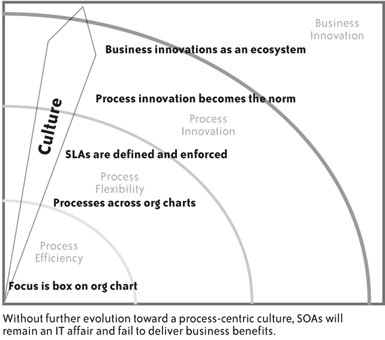Section 3.9. That s a good point, but how do you bring the two sides together in the first place?
3.9. That's a good point, but how do you bring the two sides together in the first place?Putting them in the same room to talk about something other than the latest requirements document is a good start. Bell Canada asks 1,700 business and IT staffers to attend annual "summer camps" of classes designed to bring each side up to speed on the other's most pressing challenges and foster a real conversation between the two.[*] The company has also begun to seed its higher-level IT positions with executives from business backgrounds in order to keep those conversations going internally on the IT side. Those are two small steps, but they should give you an idea of the organizational and cultural commitments necessary to open the lines of communication between the two. Asking them to collaborate on next-generation architecture will be a little more difficult, but it can be done.
Figure 3-6. Culture change: from org chart to processes and opportunities ESA adopters might borrow a page from the manufacturers who pioneered the concept of "concurrent engineering," in which representatives from every relevant department within the organization imagine entire product life cycles from conception through design, manufacture, introduction, and even disposal. At every step, designers and engineers can argue for cost-saving modifications or alternate techniques to achieve the same goals. Through close collaboration, both sides learn what is possible, what is feasible, and what the larger business goals are. When applied to IT (a concept Forrester Research has dubbed "concurrent business engineering"), the two sides collaborate on what the shape of the business itself should be and how they should implement it within IT.[
Fittingly, this is also an example of how ESA promises to transform business processes across the entire enterprise. If your IT department and line managers can break bread together on this project, then just about anything is possible. |
EAN: 2147483647
Pages: 265
 ] They brainstorm, prototype, iterate, and test together, instead of haggling over a requirements document and leaving IT to implement everything itself. The continuing dialog accelerates the speed of development and consensus on the final product, transforming what was formerly a one-sided conversation (i.e., the business side talking down to IT) into a virtuous circle of feedback, strengthening the relationship between the two and continually improving the process after each go-round.
] They brainstorm, prototype, iterate, and test together, instead of haggling over a requirements document and leaving IT to implement everything itself. The continuing dialog accelerates the speed of development and consensus on the final product, transforming what was formerly a one-sided conversation (i.e., the business side talking down to IT) into a virtuous circle of feedback, strengthening the relationship between the two and continually improving the process after each go-round. ] "Concurrent Business Engineering," Forrester Research, Inc., June 20, 2005.
] "Concurrent Business Engineering," Forrester Research, Inc., June 20, 2005.